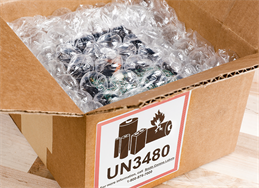
Freight insurer TT Club is seeking greater emphasis on the critical dangers of toxic gas emissions associated with lithium-ion battery fires.
TT Club said the failure of such batteries has the potential to occur with no prior warning or with such speed that there is typically no time to react to any warning signs.
In a statement, it noted the devastating consequences of rapidly spreading and often challenging to extinguish fires involving the batteries, particularly in electric vehicles (EV) on board ships and other parts of the supply chain, have been well-documented in recent months.
"There is, however, less awareness of the highly toxic combustion products that are released and their respective impact on the health and wellbeing of those exposed to the gases," the insurer said.
It noted that based on the evidence of past fires, the time between the initiation of a failed battery igniting to a discharge of toxic vapour can be measured in seconds rather than minutes.
This is due to a process known as thermal runaway.

Potential vapour volume production. [Source: TT Club]
TT Club noted that the rapid sequence of events typically occurs when an internal electrical short within one of the battery cells generates heat; this breaks down the internal structure of the battery, increasing the rate of the reaction in an ever-increasing cycle.
It further said that there is often a dramatic release of energy in the form of heat and a significant emission of toxic gases.
"During a lithium battery thermal runaway event, research has shown that significant amounts of vapour can be produced per kWh (kilowatt hour)," said Neil Dalus of TT, endeavours to paint a picture of the said danger.
"In many common supply chain scenarios, including ships' holds and warehouses, the reality is that such vapour clouds are likely to accumulate. Even when the clouds are able to disperse, the potentially toxic effects may occur at lower concentrations," he added.
Drivers, stevedores, ships' crews and first responders attempting to control the blazes encounter what might appear to be smoke but is, in fact, a mix of toxic gases generated quickly and in large volumes.
TT Club noted that these gases, once in the atmosphere, behave differently to smoke, often pooling at floor level due to their density.
"Traditionally, where fires and smoke are concerned, one would stay low to avoid inhalation, doing so where lithium battery fires are concerned is likely to prove problematic," Dalus said.
The insurer noted that the toxicity of gases given off from any given lithium-ion battery differs from that of a typical fire and can themselves vary, but all remain either poisonous or combustible, or both.
It added that they can feature high percentages of hydrogen and compounds of hydrogen, including hydrogen fluoride, hydrogen chloride and hydrogen cyanide, as well as carbon monoxide, sulphur dioxide and methane, among other dangerous chemicals.
"In terms of hazards to the well-being of those in the vicinity of such an incident, one particularly problematic component is hydrogen fluoride (HF)," the statement added.
Although HF is lighter than air and would disperse when released, a cloud of vapour and aerosol that is heavier than air may be formed (EPA 1993).
On exposure to skin or by inhaling, TT Club said HF can result in skin burns and lung damage that can take time (hours to weeks) to develop following exposure.
"HF will be quickly absorbed by the body via the skin and lungs, depleting vital calcium and magnesium levels in tissues, which can result in severe and possibly fatal systemic effects. The hydrogen content of the released gases can give rise to vapour cloud explosion risks, which have the potential to cause significant damage," it further said.
"TT advocates a range of measures to mitigate the risks. A prudent starting point would be to perform a fire risk assessment, considering the specific hazards presented by lithium-ion batteries."



